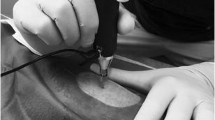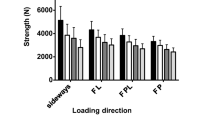Abstract
Dual X-ray absorptiometry (DXA) measures areal bone mineral density (aBMD) by simplifying a complex 3D bone structure to a 2D projection and is not equally effective for explaining fracture strength in women and men. Unlike DXA, subject-specific quantitative computed tomography-based finite element analysis (QCT/FEA) estimates fracture strength using 3D bone mineral distribution and geometry. By using experimentally-measured femoral stiffness and strength from a one hundred sample cadaveric cohort that included variations in sex and age, we wanted to determine if QCT/FEA estimates were able to better predict the experimental variations than DXA/aBMD. For each femur, DXA/aBMD was assessed and a QCT/FEA model was developed to estimate femoral stiffness and strength. Then, the femur was mechanically tested to fracture in a sideways fall on the hip position to measure stiffness and strength. DXA/aBMD and QCT/FEA estimates were compared for their sensitivity to sex and age with multivariate statistical analyses. When comparing the measured data with DXA/aBMD predictions, both age and sex were significant (p ≤ 0.0398) for both femoral stiffness and strength. However, QCT/FEA predictions of stiffness and strength showed sex was insignificant (p ≥ 0.23). Age was still significant (p ≤ 0.0072). These results indicate that QCT/FEA, unlike DXA/aBMD, accounted for bone differences due to sex.


Similar content being viewed by others
References
Augat, P., and S. Schorlemmer. The role of cortical bone and its microstructure in bone strength. Age Ageing 35:ii27–ii31, 2006.
Bousson, V., A. Meunier, C. Bergot, É. Vicaut, M. A. Rocha, M. H. Morais, A. M. Laval-Jeantet, and J. D. Laredo. Distribution of intracortical porosity in human midfemoral cortex by age and gender. J. Bone Miner. Res. 16:1308–1317, 2001.
Britz, H. M., C. D. L. Thomas, J. G. Clement, and D. M. Cooper. The relation of femoral osteon geometry to age, sex, height and weight. Bone 45:77–83, 2009.
Chen, H., S. Shoumura, S. Emura, and Y. Bunai. Regional variations of vertebral trabecular bone microstructure with age and gender. Osteoporos. Int. 19:1473–1483, 2008.
Cody, D. D., G. J. Gross, F. J. Hou, H. J. Spencer, S. A. Goldstein, and D. P. Fyhrie. Femoral strength is better predicted by finite element models than QCT and DXA. J. Biomech. 32:1013–1020, 1999.
Cristofolini, L., M. Juszczyk, S. Martelli, F. Taddei, and M. Viceconti. In vitro replication of spontaneous fractures of the proximal human femur. J. Biomech. 40:2837–2845, 2007.
Cummings, S. R., P. M. Cawthon, K. E. Ensrud, J. A. Cauley, H. A. Fink, and E. S. Orwoll. BMD and risk of hip and nonvertebral fractures in older men: a prospective study and comparison with older women. J. Bone Miner. Res. 21:7, 2006.
Dall’Ara, E., R. Eastell, M. Viceconti, D. Pahr, and L. Yang. Experimental validation of DXA-based finite element models for prediction of femoral strength. J. Mech. Behav. Biomed. Mater. 63:17–25, 2016.
Dragomir-Daescu, D., J. Op Den Buijs, S. McEligot, Y. Dai, R. C. Entwistle, C. Salas, L. J. Melton, 3rd, K. E. Bennet, S. Khosla, and S. Amin. Robust QCT/FEA models of proximal femur stiffness and fracture load during a sideways fall on the hip. Ann. Biomed. Eng. 39:742–755, 2011.
Dragomir-Daescu, D., A. Rezaei, T. Rossman, S. Uthamaraj, R. Entwistle, S. McEligot, V. Lambert, H. Giambini, I. Jasiuk, M. Yaszemski, and L. Lichun. Method and instrumented fixture for femoral fracture testing in a sideways fall-on-the-hip position. JoVE 2017. doi:10.3791/54928.
Dragomir-Daescu, D., A. Rezaei, S. Uthamaraj, T. Rossman, J. T. Bronk, M. Bolander, V. Lambert, S. McEligot, R. Entwistle, H. Giambini, I. Jasiuk, M. Yaszemski, and L. Lichun. Proximal cadaveric femur preparation for fracture strength testing and quantitative CT-based finite element analysis. JoVE 121:e54925–e54925, 2017.
Gilchrist, S., K. Nishiyama, P. De Bakker, P. Guy, S. Boyd, T. Oxland, and P. Cripton. Proximal femur elastic behaviour is the same in impact and constant displacement rate fall simulation. J. Biomech. 47:3744–3749, 2014.
Hambli, R., and S. Allaoui. A robust 3D finite element simulation of human proximal femur progressive fracture under stance load with experimental validation. Ann. Biomed. Eng. 41:2515–2527, 2013.
Kanis, J. A. Diagnosis of osteoporosis and assessment of fracture risk. Lancet 359:1929–1936, 2002.
Kanis, J. A., L. J. Melton, C. Christiansen, C. C. Johnston, and N. Khaltaev. The diagnosis of osteoporosis. J. Bone Miner. Res. 9:1137–1141, 1994.
Keaveny, T. M., D. L. Kopperdahl, L. J. Melton, P. F. Hoffmann, S. Amin, B. L. Riggs, and S. Khosla. Age-dependence of femoral strength in white women and men. J. Bone Miner. Res. 25:994–1001, 2010.
Keyak, J. H., T. S. Kaneko, J. Tehranzadeh, and H. B. Skinner. Predicting proximal femoral strength using structural engineering models. Clin. Orthop. Relat. Res. 437:219–228, 2005.
Keyak, J. H., and S. A. Rossi. Prediction of femoral fracture load using finite element models: an examination of stress-and strain-based failure theories. J. Biomech. 33:209–214, 2000.
Keyak, J., S. Rossi, K. Jones, C. Les, and H. Skinner. Prediction of fracture location in the proximal femur using finite element models. Med. Eng Phys. 23:657–664, 2001.
Koivumäki, J. E., J. Thevenot, P. Pulkkinen, V. Kuhn, T. M. Link, F. Eckstein, and T. Jämsä. Ct-based finite element models can be used to estimate experimentally measured failure loads in the proximal femur. Bone 50:824–829, 2012.
Kutner, M. H., C. Nachtsheim, and J. Neter. Applied Linear Regression Models. New York: McGraw-Hill/Irwin, 2004.
Launey, M. E., M. J. Buehler, and R. O. Ritchie. On the mechanistic origins of toughness in bone. Annu. Rev. Mater. Res. 40:25–53, 2010.
Mirzaali, M. J., J. J. Schwiedrzik, S. Thaiwichai, J. P. Best, J. Michler, P. K. Zysset, and U. Wolfram. Mechanical properties of cortical bone and their relationships with age, gender, composition and microindentation properties in the elderly. Bone 93:196–211, 2016.
Mirzaei, M., M. Keshavarzian, and V. Naeini. Analysis of strength and failure pattern of human proximal femur using quantitative computed tomography (QCT)-based finite element method. Bone 64:108–114, 2014.
Morgan, E. F., H. H. Bayraktar, and T. M. Keaveny. Trabecular bone modulus–density relationships depend on anatomic site. J. Biomech. 36:897–904, 2003.
Nasiri, M., and Y. Luo. Study of sex differences in the association between hip fracture risk and body parameters by DXA-based biomechanical modeling. Bone 90:90–98, 2016.
Rezaei, A., and D. Dragomir-Daescu. Femoral strength changes faster with age than BMD in both women and men: a biomechanical study. J. Bone Miner. Res. 30:2200–2206, 2015.
Rossman, T., V. Kushvaha, and D. Dragomir-Daescu. QCT/FEA predictions of femoral stiffness are strongly affected by boundary condition modeling. Comput. Methods Biomech. Biomed. Eng. 19:208–216, 2016.
Sabet, F. A., A. R. Najafi, E. Hamed, and I. Jasiuk. Modelling of bone fracture and strength at different length scales: a review. Interface Focus 6:20150055, 2016.
Seref-Ferlengez, Z., O. D. Kennedy, and M. B. Schaffler. Bone microdamage, remodeling and bone fragility: how much damage is too much damage [quest]. BoneKEy Rep. 4:644, 2015.
Thomas, C. D. L., S. A. Feik, and J. G. Clement. Regional variation of intracortical porosity in the midshaft of the human femur: age and sex differences. J. Anat. 206:115–125, 2005.
Unnanuntana, A., B. P. Gladnick, E. Donnelly, and J. M. Lane. The assessment of fracture risk. J. Bone Joint Surg. 92:743–753, 2010.
Acknowledgments
The study was financially supported by the Grainger Foundation: Grainger Innovation Fund. The CT imaging of the femurs was performed through the Opus CT Imaging Resource of Mayo Clinic (NIH construction Grant RR018898). This publication was made possible by CTSA Grant Number UL1 TR000135 from the National Center for Advancing Translational Sciences (NCATS), a component of the National Institutes of Health (NIH).
Conflict of interest
The authors declare that they have no conflict of interest.
Author information
Authors and Affiliations
Corresponding author
Additional information
Associate Editor Sean S. Kohles oversaw the review of this article.
Rights and permissions
About this article
Cite this article
Rezaei, A., Giambini, H., Rossman, T. et al. Are DXA/aBMD and QCT/FEA Stiffness and Strength Estimates Sensitive to Sex and Age?. Ann Biomed Eng 45, 2847–2856 (2017). https://doi.org/10.1007/s10439-017-1914-5
Received:
Accepted:
Published:
Issue Date:
DOI: https://doi.org/10.1007/s10439-017-1914-5




